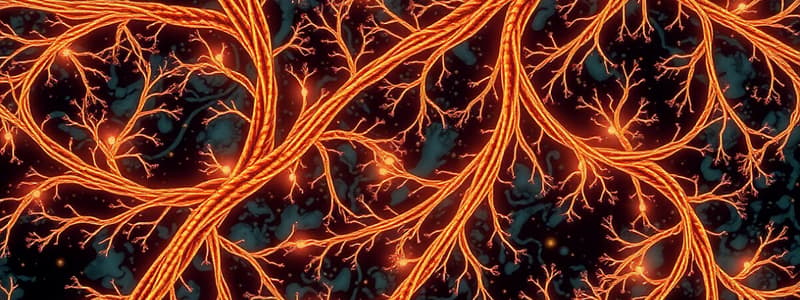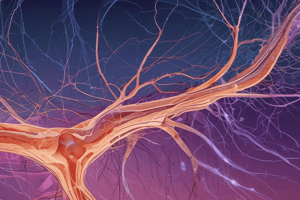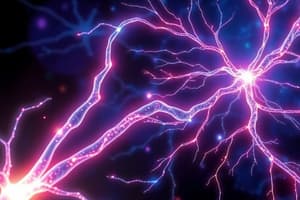Podcast
Questions and Answers
What is the primary role of the myelin sheath in nerve fibers?
What is the primary role of the myelin sheath in nerve fibers?
- To provide structural support to the neuron
- To protect the axon from damage
- To prevent the loss of neurotransmitters
- To enhance the speed of nerve impulse propagation (correct)
What process allows the action potential to jump from one node to the next in myelinated nerve fibers?
What process allows the action potential to jump from one node to the next in myelinated nerve fibers?
- Continuous conduction
- Electrical conduction
- Saltatory conduction (correct)
- Synaptic transmission
Which statement correctly describes the nodes of Ranvier?
Which statement correctly describes the nodes of Ranvier?
- They are located at the terminals of axons
- They are gaps in the myelin sheath (correct)
- They are the areas where myelination occurs
- They serve as sites for neurotransmitter release
What type of motor nerve is responsible for voluntary control over skeletal muscles?
What type of motor nerve is responsible for voluntary control over skeletal muscles?
Which component surrounds each peripheral nerve (PN) and provides connective tissue support?
Which component surrounds each peripheral nerve (PN) and provides connective tissue support?
What is the primary purpose of the Schwann cell in the peripheral nervous system?
What is the primary purpose of the Schwann cell in the peripheral nervous system?
Which layer of connective tissue surrounds individual nerve fibers in a peripheral nerve?
Which layer of connective tissue surrounds individual nerve fibers in a peripheral nerve?
What is a characteristic of the myelin sheath formed by Schwann cells?
What is a characteristic of the myelin sheath formed by Schwann cells?
How are myelinated and non-myelinated nerve fibers classified?
How are myelinated and non-myelinated nerve fibers classified?
Which structure is NOT included under the classification of nerve fibers in the PNS?
Which structure is NOT included under the classification of nerve fibers in the PNS?
Which type of nerve fiber typically has a faster conduction velocity?
Which type of nerve fiber typically has a faster conduction velocity?
What is the function of oligodendroglia in relation to the myelin sheath?
What is the function of oligodendroglia in relation to the myelin sheath?
In which nerve plexus is the cervical plexus located?
In which nerve plexus is the cervical plexus located?
Which type of nerve fibers is specifically surrounded by a myelin sheath?
Which type of nerve fibers is specifically surrounded by a myelin sheath?
What is the function of neuromuscular spindles?
What is the function of neuromuscular spindles?
Which cells are responsible for myelination in the central nervous system?
Which cells are responsible for myelination in the central nervous system?
What marks the unmyelinated parts of an axon?
What marks the unmyelinated parts of an axon?
Which term describes the area of skin innervated by a single spinal nerve root?
Which term describes the area of skin innervated by a single spinal nerve root?
What is Wallerian degeneration?
What is Wallerian degeneration?
What component is primarily associated with motor innervation?
What component is primarily associated with motor innervation?
Which type of axon typically has a diameter greater than 1 μm and is myelinated?
Which type of axon typically has a diameter greater than 1 μm and is myelinated?
Flashcards are hidden until you start studying
Study Notes
Nerve Fibers
- Nerve fibers are either axons or dendrites.
- Nerve fibers are part of the peripheral nerves (PNS) and compose the nerve tracts (CNS).
- Nerve fibers are classified as myelinated or non-myelinated.
Myelinated Nerve Fibers
- Myelinated nerve fibers surround the nerve fiber.
- Myelination in the central nervous system (CNS) is performed by oligodendrocytes.
- One oligodendrocyte can myelinate up to 60 axons in the CNS.
- Myelination in the peripheral nervous system (PNS) is performed by Schwann cells.
- One schwann cell can only myelinate one internode of a single axon in the PNS.
- Schwann cells form one myelin segment.
- Most axons with a diameter greater than 1μm are typically myelinated.
- Myelination is formed by the wrapping of the neuroglia around the axon.
- The myelin sheath is a segmented, discontinuous layer that acts as an insulator to increase the speed of nerve impulses.
- The myelin sheath is not formed by the neuron, but rather by dedicated neurogllia.
Non-Myelinated Nerve Fibers
- The nerve fiber is not surrounded by a myelin sheath.
- The axon is not wrapped by neuroglia.
Peripheral Nerves
- Peripheral nerves are collections of nerve fibers located outside the CNS.
- Peripheral nerves are comprised of both myelinated and non-myelinated fibers.
- Peripheral nerves transmit nerve impulses to and from the CNS.
- Peripheral nerves consist of 12 pairs of cranial and 31 pairs of spinal nerves.
- Each peripheral nerve is covered by connective tissue sheath.
Connective Tissue Sheaths
- Connective tissue sheaths cover each peripheral nerve.
- There are three parts to the connective tissue sheath:
- Epineurium: the outermost covering of the peripheral nerve.
- Perineurium: a middle layer covering nerve fascicles.
- Endoneurium: the innermost layer covering individual nerve fibers.
Nodes of Ranvier
- Nodes of Ranvier are unmyelinated gaps between segments of the myelin sheath.
- Depolarization of the membrane occurs at the Node of Ranvier.
- Saltatory conduction occurs in myelinated nerve fibers.
- Action potentials jump from one node to the next, resulting in faster propagation of nerve impulse.
Autonomic Nervous System
- The autonomic nervous system (ANS) is responsible for regulating involuntary functions such as heart rate, digestion, and breathing.
- The ANS is divided into sympathetic and parasympathetic divisions.
Sympathetic Division
- The sympathetic division prepares the body for "fight-or-flight" responses.
- Sympathetic nerves originate from the thoracic and lumbar regions of the spinal cord.
- Sympathetic nerves stimulate the release of adrenaline (epinephrine) and noradrenaline (norepinephrine).
Parasympathetic Division
- The parasympathetic division promotes "rest and digest" functions.
- Parasympathetic nerves originate from the brain stem and sacral region of the spinal cord.
- Parasympathetic nerves stimulate the release of acetylcholine.
### Dermatomes and Muscle Activity
- Dermatome: An area of skin innervated by a single spinal nerve root.
- Myotome: A group of muscles innervated by a single spinal nerve root.
- Muscle Tone: The state of continuous partial contraction that is present in resting muscles which helps maintain posture and stability.
Axonal Injuries
- Wallerian Degeneration: The degeneration of the axon distal to the site of injury.
- Myelinated nerve fibers are more vulnerable to injury than non-myelinated fibers.
- Following injury, the axon proximal to the injury regenerates and grows towards the distal segment.
- Regeneration can be facilitated by growth factors.
- The speed and success of regeneration depends on the severity of the injury and the distance between the injury site and the target organ.
### Receptors
- Receptors: Specialized cells or structures that respond to specific stimuli.
- Sensory receptors can be classified by:
- Type of stimulus they respond to: e.g. mechanoreceptors, thermoreceptors, chemoreceptors.
- Rate of adaptation: e.g. rapidly adapting, slowly adapting.
- Structural complexity: e.g. simple receptors, complex receptors.
### Neuromuscular Spindles
- Neuromuscular Spindles: Sensory receptors located within skeletal muscle that detect changes in muscle length and rate of change.
- Types of sensory innervation:
- Primary sensory endings: Respond to changes in muscle length.
- Secondary sensory endings: Detect the rate of change in muscle length.
Neurotendinous Spindles
- Neurotendinous Spindles (Golgi Tendon Organs): Sensory receptors located within tendons that detect changes in muscle tension.
- Golgi tendon organs are sensitive to both static and dynamic tension.
- Golgi tendon organs play a role in preventing excessive muscle contraction.
Effector Endings
- Motor Innervation: Nerve fibers that transmit signals from the central nervous system to muscles, causing them to contract.
- Sensory Innervation: Nerve fibers that transmit signals from sensory receptors to the central nervous system.
Motor Unit
- Motor Unit: A single motor neuron and all the muscle fibers it innervates.
- The size of a motor unit can vary depending on the muscle function. Fine motor control requires smaller motor units.
Neuromuscular Junction in Skeletal Muscles
- Neuromuscular Junction: The synapse between a motor neuron and a skeletal muscle fiber.
- Muscle Depolarization and Contraction:
- When a nerve impulse reaches the axon terminal at the neuromuscular junction, it triggers the release of acetylcholine.
- Acetylcholine binds to receptors on the muscle fiber membrane, causing depolarization and an action potential.
- This action potential triggers the release of calcium within the muscle fiber, which initiates the sliding filament mechanism of muscle contraction.
Neuromuscular Junction in Cardiac and Smooth Muscle
- Cardiac Muscle: Neuromuscular junctions in cardiac muscle are similar to those in skeletal muscle, but they are not as well-defined.
- Smooth Muscle: Neuromuscular junctions in smooth muscle are different from those in skeletal muscle.
- Many smooth muscle fibers lack a clearly defined neuromuscular junction and may be innervated by varicosities along the axon.
### Peripheral Nerve Plexus
- Peripheral nerve plexuses are networks of interconnecting nerve fibers that originate from different spinal nerves.
- Peripheral nerve plexuses allow for more complex motor and sensory control.
- The major peripheral nerve plexuses include:
- Cervical Plexus: Innervates muscles and skin of the neck and shoulders.
- Brachial Plexus: Innervates muscles and skin of the upper limb.
- Lumbar and Sacral Plexuses: Innervate muscles and skin of the lower limbs.
### The End
Studying That Suits You
Use AI to generate personalized quizzes and flashcards to suit your learning preferences.




